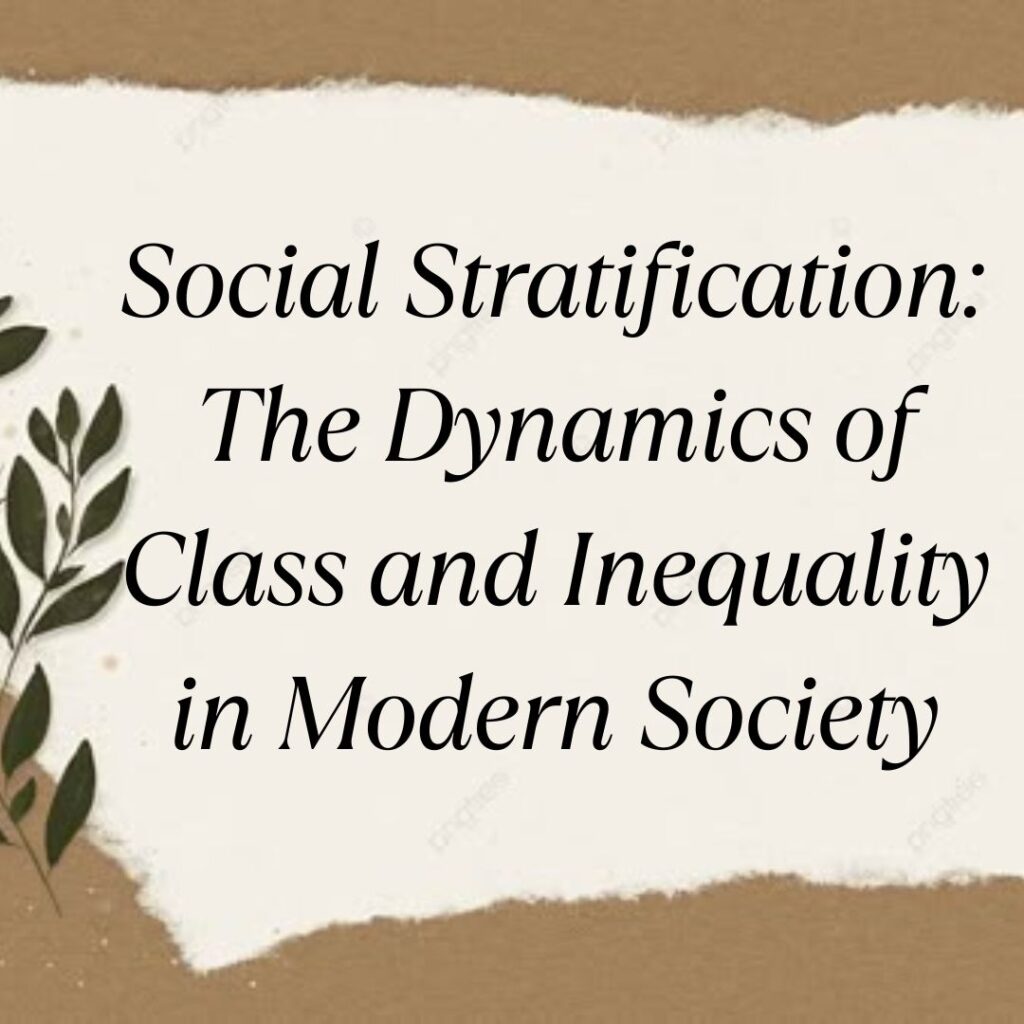Social stratification has long been a fundamental aspect of human societies, shaping the way we interact, the opportunities we have, and the lives we lead. From ancient civilizations to contemporary societies, the division of people into various classes has influenced everything from politics to personal relationships. In modern times, understanding social stratification is more critical than ever, as it affects every aspect of our lives and the fabric of our communities.
What is Social Stratification?
At its core, social stratification refers to the hierarchical arrangement of individuals in a society based on various factors such as wealth, income, education, occupation, and social status. This hierarchy results in the categorization of people into different social classes, which often come with distinct advantages and disadvantages. The most common forms of stratification include class, caste, and status groups.
The Basis of Stratification
- Economic Factors: Wealth and income are primary determinants of social class. Those with greater financial resources typically have access to better education, healthcare, and living conditions.
- Social Factors: Social status, often tied to one’s occupation and lifestyle, also plays a crucial role. Professions like doctors, lawyers, and engineers are usually held in high esteem and are associated with higher social status.
- Cultural Factors: Cultural capital, which includes education, intellect, style of speech, dress, or physical appearance, can affect social mobility and class status. For instance, attending prestigious schools or universities can open doors to higher social circles.
- Political Factors: Access to political power and influence can also determine one’s position in the social hierarchy. Political leaders and influential figures often belong to the upper echelons of society.
Historical Context of Social Stratification
Social stratification is not a new phenomenon. Historically, societies have always had some form of hierarchy. For example:
- Ancient Egypt: The society was divided into a strict hierarchy with the Pharaoh at the top, followed by priests, nobles, soldiers, scribes, merchants, and slaves.
- Feudal Europe: The feudal system categorized people into distinct classes such as the king, nobility, knights, and peasants. Land ownership and loyalty to the king were key factors in determining one’s class.
- Indian Caste System: One of the oldest forms of social stratification, the caste system divides people into rigid hereditary groups based on their karma (work) and dharma (duty). This system has persisted for thousands of years, deeply influencing Indian society.
Social Stratification in Modern Society
Class Structure Today
In contemporary society, class structure is often more fluid than in historical contexts, but significant divisions still exist. The major classes typically include:
- Upper Class: This group comprises the wealthiest individuals, often those who own significant property, businesses, or investments. They have substantial influence over the economy and politics.
- Middle Class: Often considered the backbone of society, the middle class includes professionals, small business owners, and skilled workers. They typically have stable incomes and access to education and healthcare.
- Working Class: This group includes individuals who perform manual labor or work in service industries. They often face economic instability and have limited access to higher education.
- Underclass: The underclass consists of individuals who experience long-term unemployment, poverty, and lack of social mobility. They often rely on government assistance and face significant barriers to improving their socioeconomic status.
The Impact of Globalization
Globalization has significantly affected social stratification. While it has created opportunities for economic growth and development, it has also led to increased inequality. For example, multinational corporations can create wealth and jobs, but they often pay low wages and provide poor working conditions in developing countries. This dynamic perpetuates a global class system where wealth and power are concentrated in the hands of a few.
Education and Social Mobility
Education is often seen as a pathway to social mobility. However, access to quality education is unevenly distributed, perpetuating class divisions. In many countries, children from wealthier families attend better schools, receive more academic support, and have greater opportunities for higher education. Conversely, children from lower-income families often face significant educational disadvantages, limiting their ability to climb the social ladder.
Technology and the Digital Divide
Technology has transformed society in many ways, but it has also contributed to new forms of stratification. The digital divide refers to the gap between those who have access to modern information and communication technology and those who do not. Individuals with access to the internet, computers, and digital literacy skills are better positioned to succeed in today’s economy, while those without these resources are left behind.
Contemporary Examples of Social Stratification
The United States
In the United States, social stratification is evident in various aspects of life. The gap between the rich and the poor has been widening for decades. The wealthiest 1% of Americans hold a significant portion of the nation’s wealth, while many middle- and lower-income families struggle to make ends meet. Factors such as racial inequality, access to education, and healthcare disparities further compound these issues.
India
Despite economic growth and modernization, India continues to grapple with the legacy of the caste system. While legal reforms have been implemented to reduce caste-based discrimination, social and economic inequalities persist. Many individuals from lower castes face limited access to education, employment opportunities, and social mobility.
Brazil
Brazil is another example of a country with stark social stratification. Despite being one of the largest economies in Latin America, Brazil has high levels of income inequality. The affluent live in luxury, while many others reside in favelas (slums) with poor living conditions and limited access to basic services.
Addressing Social Stratification
Policy Interventions
Governments can play a crucial role in reducing social stratification through various policy interventions:
- Progressive Taxation: Implementing progressive tax systems can help redistribute wealth and reduce income inequality. Higher taxes on the wealthy can fund public services and social programs that benefit lower-income individuals.
- Education Reform: Ensuring equal access to quality education is vital for promoting social mobility. Policies that provide scholarships, improve public schools, and reduce the cost of higher education can help level the playing field.
- Social Welfare Programs: Social safety nets, such as unemployment benefits, healthcare, and housing assistance, can alleviate the hardships faced by lower-income individuals and provide opportunities for upward mobility.
Community Initiatives
Community-based initiatives can also help address social stratification:
- Grassroots Organizations: Local organizations that provide support, education, and resources to disadvantaged communities can empower individuals and promote social cohesion.
- Job Training Programs: Offering vocational training and job placement services can help individuals acquire the skills needed to secure stable employment and improve their socioeconomic status.
- Mentorship and Networking: Mentorship programs that connect individuals from different social backgrounds can provide guidance, support, and opportunities for personal and professional growth.
The Future of Social Stratification
As we move forward, it is crucial to address the root causes of social stratification and work towards a more equitable society. Technological advancements, changing economic landscapes, and evolving social norms will continue to shape the dynamics of class and inequality. By implementing effective policies, fostering community initiatives, and promoting equal opportunities, we can create a society where everyone has the chance to thrive, regardless of their social background.
In conclusion, social stratification remains a pervasive and complex issue in modern society. Understanding its dynamics and addressing its challenges is essential for creating a more just and equitable world. By recognizing the impact of class and inequality on our lives and taking action to reduce these disparities, we can build a brighter future for all.







